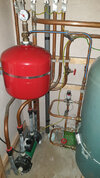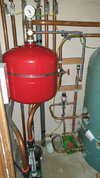I had a new 18L EV for my heating system fitted today. It came with a 1.5 bar pre-charge and that's how it was fitted. I forgot to suggest to the plumber that it be reduced to about 1 bar before fitting. The EV is mounted with the water feed at the top and nitrogen at the bottom.
I am seeing the pressure vary between 1 bar (cold) and 2 bar (hot). My EV is the highest point in my heating (only just) and when the system is hot, the pipework leading to the top of EV is cold. To me this would suggest that there is air trapped at this high point from the work earlier today?
Is this likely to be the case and if so how can I bleed it? I will attach some photos to better explain the situation. The blue area is where it is cold. The pipework below the blue area is hot.
I am seeing the pressure vary between 1 bar (cold) and 2 bar (hot). My EV is the highest point in my heating (only just) and when the system is hot, the pipework leading to the top of EV is cold. To me this would suggest that there is air trapped at this high point from the work earlier today?
Is this likely to be the case and if so how can I bleed it? I will attach some photos to better explain the situation. The blue area is where it is cold. The pipework below the blue area is hot.
Attachments
Last edited:



